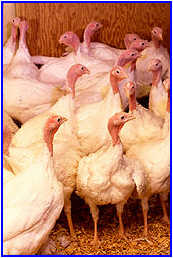



A Quicker, Cheaper Test for Turkey Viruses
WASHINGTON - An innovative test to detect Salmonella in ready-to-eat meats has been developed by Agricultural Research Service (ARS) scientists. The preliminary test--still being evaluated by agency researchers - relies on PCR (polymerase chain reaction) technology to detect food-contaminating microbes on a molecular level.
A Quicker, Cheaper Test for Turkey Viruses - WASHINGTON - An innovative test to detect Salmonella in ready-to-eat meats has been developed by Agricultural Research Service (ARS) scientists. The preliminary test--still being evaluated by agency researchers - relies on PCR (polymerase chain reaction) technology to detect food-contaminating microbes on a molecular level.
A new, highly sensitive diagnostic test to detect viruses associated with poult enteritis complex, or PEC, has been developed by Agricultural Research Service (ARS) scientists in Athens, Ga. This disease of young turkeys causes diarrhea, poor weight gain and, in some cases, high mortality.
Microbiologists Erica Spackman and Darrell Kapczynski developed the test in a format that allows the detection of several types of viruses at one time. Spackman works in the ARS Endemic Poultry Viral Diseases Research Unit, and Kapczynski is in the Exotic and Emerging Avian Viral Disease Research Unit. Both units are part of the ARS Southeast Poultry Research Laboratory. The scientists collaborated on the research with Holly Sellers of the University of Georgia.
The test relies on a molecular technique called real-time reverse transcription- polymerase chain reaction (RRT-PCR), which is a highly sensitive and specific method for detecting viral RNA. Current diagnostic methods for PEC-associated viruses have limitations because of poor analytic specificity and sensitivity.
The researchers inoculated turkey poults with each of the PEC-associated viruses and later collected intestinal tissue samples and cloacal swabs from the experimentally infected birds. The RRT-PCR test showed high sensitivity, accurately detecting the target viruses in both the tissues and swabs.
While intestinal samples have previously been essential to making a definitive PEC diagnosis, the researchers found that cloacal samples—which are easier to collect and process—were just as suitable for testing. Using them will not only save time and money, it will also eliminate the need to euthanize birds for sampling.
The PEC-test technology has been provided to several laboratories for diagnostic use, and the research team is now working on adapting the RRT-PCR technique to diagnose related diseases in chickens.
Source: USDA Agricultural Research Service - 29th May 2006
 |
 |
 Healthy young turkeys |
Microbiologists Erica Spackman and Darrell Kapczynski developed the test in a format that allows the detection of several types of viruses at one time. Spackman works in the ARS Endemic Poultry Viral Diseases Research Unit, and Kapczynski is in the Exotic and Emerging Avian Viral Disease Research Unit. Both units are part of the ARS Southeast Poultry Research Laboratory. The scientists collaborated on the research with Holly Sellers of the University of Georgia.
The test relies on a molecular technique called real-time reverse transcription- polymerase chain reaction (RRT-PCR), which is a highly sensitive and specific method for detecting viral RNA. Current diagnostic methods for PEC-associated viruses have limitations because of poor analytic specificity and sensitivity.
The researchers inoculated turkey poults with each of the PEC-associated viruses and later collected intestinal tissue samples and cloacal swabs from the experimentally infected birds. The RRT-PCR test showed high sensitivity, accurately detecting the target viruses in both the tissues and swabs.
While intestinal samples have previously been essential to making a definitive PEC diagnosis, the researchers found that cloacal samples—which are easier to collect and process—were just as suitable for testing. Using them will not only save time and money, it will also eliminate the need to euthanize birds for sampling.
The PEC-test technology has been provided to several laboratories for diagnostic use, and the research team is now working on adapting the RRT-PCR technique to diagnose related diseases in chickens.
Source: USDA Agricultural Research Service - 29th May 2006








